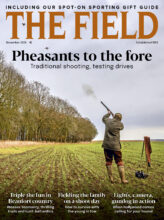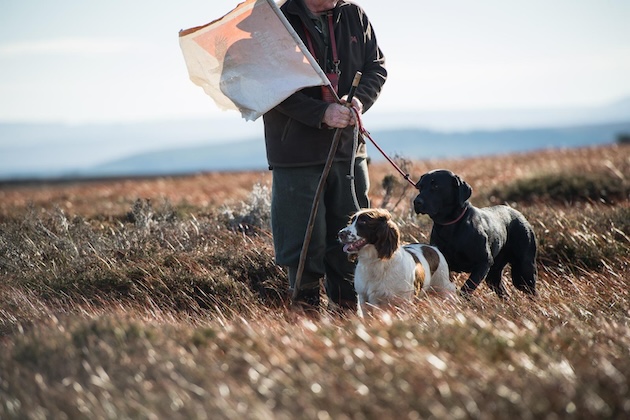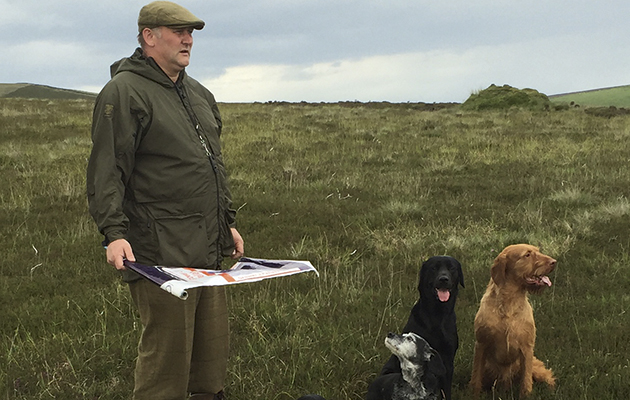Grouse beaters are the warriors of the hill, says Janet Menzies
Grouse beaters have to walk about 15 miles a day across difficult, upland terrain in all weather conditions whilst being shouted at from every direction. But despite the demanding conditions, grouse moors are never short of volunteers. Why is this? Janet Menzies finds out who exactly is signing up. (Read George Digweed’s guide to grouse shooting.)
Grouse beaters
The scene is straight out of Zulu. Your grouse butt is the mission station at Rorke’s Drift, its stone and peat-turf construction your gun emplacement, with cartridges and guns set ready for the imaginary commands: “Front rank, fire! Second rank, fire! Reload…” And, sure enough, there on the horizon, where heather-hill meets the sky, dark figures are silhouetted. They gather in a long line across the moor.
Who are the grouse beaters? That is a complex question.
It is really impossible to describe the typical grouse beater.
You will find students from Manchester living in the estate bothy for the season and beating grouse much as it used to be fashionable to go grape-picking in the Eighties. There are wiry, ageless Irishmen with packs of pointers and setters. Fell-runners and fitness freaks relish the prospect of a two-mile vertical climb through driving rain. Even journalists with over-active imaginations have been known to stride across the heather if the weather is nice, at least as far as the flank. And, of course, there are the professionals – beat keepers, dog workers, estate workers – and the local teenagers. (Read grouse shots you need to know.)

It’s all about the walking
All about the walking
Because, at the end of the day, for grouse beaters it is all about the walking. Keith Pearce is a pharmaceuticals process technician based near Ulverston in Cumbria and his journey to go grouse beating at Wemmergill in County Durham is a round trip of more than 100 miles. Pearce describes an average grouse day: “I am up by 5.30 in the morning to get the dogs sorted and get ready, and by then the other lads will have arrived at my house and we have to try and drag my son out of bed. We have a great craic on the drive. There could be five of us squashed in the pick-up and 10 or so dogs packed in the back and off we go.” Then the real work begins: “The younger lads will be beating the whole day. My son has been coming with me since he was 11 and these days he’s taken over the beating from me so I can go in the flank, which isn’t so much walking.”

Beater Derek O’Neill from Strathaven, South Lanarkshire, who in his busiest season did 50 days beating.
When light and weather allows, keepers will try to fit in five or six drives, shooting well into the late afternoon. Then it’s time to cram everyone back into the pick-up and get home after a 14-hour day. But, says Pearce, “It’s worth it. I do a three days on/off system at work and I will try to get to the grousemoor every day I can. It is being out in the countryside – the area is beautiful. It is a magical thing really, I never sleep the night before the first day of the season.”
Grouse beating seems to exert some sort of mystical force over its participants. Derek O’Neill says: “In my busiest beating season I must have done 50 days.” O’Neill tries to sum up the magic of beating: “When you reach the end of the drive on a beautiful day and it’s all gone well, and you lie down in the heather for a breather, you just can’t better that feeling. With grouse you never know what to expect. They are a truly wild quarry and later in the season, getting them to fly over the butts is quite a challenge.”
Ample volunteers
Given that, to ordinary mortals, beating might seem like a tough way of earning £50, it is perhaps surprising that grouse moors find ample volunteers. A head keeper says: “On a normal grouse day we have about 24 grouse beaters, six flankers and three or four pickers-up, and it can be a bit of a nightmare sometimes to get enough of the right people. Really, the most important thing is that you have to be physically fit.”
Grouse beaters are essentially a nomadic tribe, marching regularly across the marches of neighbouring estates as required to swell the ranks. When the word goes out from Balmoral, beaters from central Highland estates are bussed in over the high passes of the Cairngorms as additional beaters, flankers, boot-washers, cup-holders, people carriers and anything else deemed necessary for a Royal grouse shoot. For Wemmergill and its sister moor, Holwick, nearby Bishop Auckland is a source of manpower. Long-time regular flanker Bill Kerr explains: “There’s quite a lot of unemployment in the area and for many lads the grouse season is the one time of the year they get a chance to come off unemployment and earn some money.”
Conservation
Kerr has been beating at Wemmergill and Holwick for more than 20 years and has seen huge strides taken in conservation over that time. “The moor is a much better place now,” he says. “There has been planting to encourage black grouse – and we have lapwing and golden plover. We are even seeing merlin coming back to hunt all the smaller birds like pipit, which have increased so much.”
A lifestyle
Bringing his grandchildren up to visit the moor all year round is what makes grouse beating special for Kerr. “Beating is a lifestyle all its own. It is about being part of the big picture as opposed to just turning up. We grouse beaters keep in touch with each other all year round and we are involved with the life of the moor.”
This is exactly what watercolour artist Jason Lowes tries to capture in his paintings of his local County Durham grousemoors. Along with his brothers and sisters, it was assumed that, as a local lad, Lowes would go beating. “It was just something we all did. When I started it was pocket money – and, from your parents’ point of view, it kept you out of trouble because after five days in a row of beating, you don’t have the energy for mischief. I was always into the moors and the wildlife generally but I think at that early stage of beating I didn’t have the love of grouse that I put into my paintings today.”
Paige Thompson also started beating as a teenager, about five years ago. Now 20 years old, she has just begun her training for the Royal Military Police and found fitness not to be much of an issue. “All my grouse beating has definitely helped with the military fitness levels. There’s a kind of fast walk/march that you do, which hasn’t been a challenge for me because beating keeps you really fit. It’s a great summer job if you are at school or university.”
Fitness
Karen Bell beats regularly on Wemmergill. “This will be my third season of grouse beating,” says Bell. “I’m a fell runner as well as a professional fitness instructor, so I was already very fit but I must admit I got a shock the first day I did it because it is so completely different, with really demanding terrain and you need stamina.”
These grouse beaters obviously are a regiment of foot.
This article was originally published in 2015 and has been updated.







